
Communities and the Public Imaginary – Ten Years of the Poetry of the Wild Project
by Suzanne MacAulay, Ph.D., from a paper presented at the Folkarts Society Conference.
This discussion examines the many variations over the past ten years of the collaborative and public project of Poetry of the Wild (POW) comprised of poetry boxes (i.e., literary bird houses), installed on trails, in parks, along rivers as well as library stacks (Dewey Decimal address: English poetry, 811). In this context cultural sustainability and poetic sensibility deepen our understanding of sense of place, environmental aesthetics, shrine markers, and the breadth of individual and communal creative and performative action.
“…out for a walk…”
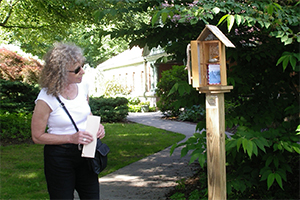
Ana Flores conceived Poetry of the Wild (POW) in 2003 when she was an artist-in-residence at the Wood-Pawcatuck Watershed in Rhode Island. Flores’ art making really defies conventional categorization but she is usually regarded as an environmental artist, activist, and masterful collaborator.
POW is an ongoing artistic and literary project that according to Ana’s conception invites the public ‘out for a walk’ to freshly experience their world through word, sound and image. Inspired by the architectural design of birdhouses, these unique configurations of ‘poetry boxes,’ combining art and poetry located in communal open spaces, solicit a public response and become catalysts for exploring our environs and questioning how a sense of place informs our consciousness. Akin to a treasure hunt, hikers and walkers encounter poetry boxes in unexpected places. The presence of poetry boxes in the landscape fosters a kind of intentionality – a purpose – to walking.
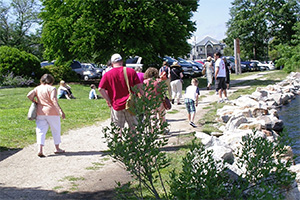
David Madasci, physicist and artist as well as POW participant, speaking of the installation of boxes at Avery Point on the University of Connecticut Groton campus, believes that the presence of the boxes at that site on the edge of Long Island Sound “refocuses your being here, being in this environment. Refocusing happens with each pause – each stop. That is the function of this group of boxes. [They] keep the initial impetus for walking alive.”
In this way, the public becomes engaged through discovery, by reading the poems in the boxes, experiencing the locations, and writing a poem or a response in a journal kept inside each box. (Poetry ‘stewards’ collect these public writings every week for the duration of each project). Poetry of the Wild has involved poets, poet laureates, students, interested citizen-artists, professional artists, librarians, teachers, professors, etc. Different locations include areas in Connecticut, Rhode Island, Colorado and England with community partners ranging from public libraries, galleries, art centers, universities, and city councils.
The concept behind this project, graphically illustrates the essence of the meaning of folklore and its application as summed up years ago by folklorist Dan Ben-Amos as “artistic communication in small groups.” The human mosaic of Poetry in the Wild is composed of ‘small groups’ interacting on a variety of social, environmental and aesthetic tiers. This lends itself to a rich analysis of intersections both in terms of group dynamics but also relevant to ecological factors, collaborations, community partnerships, and creative responses. The primary concerns of folklore interpretation such as tradition, identity (individual, group, community), cultural creativity, performance and narrative analysis, are just a few of the dynamics that can be teased from investigating a project with such interesting cultural parameters as Poetry of the Wild.
Not only am I examining relationships among individual and collective creative impulses, but also interrogating the perceived communal ethos, environmental politics and poetics vis-à-vis a folkloristic interpretation of how these different spheres of action and imagination are conceptualized on all levels of participation and either corroborated or rejected. This expansive outlook encompasses an analysis of ‘sense of place,’ performance, and poetry boxes as shrine markers as indicators of ceremonial or sacred space.
Senses of Place
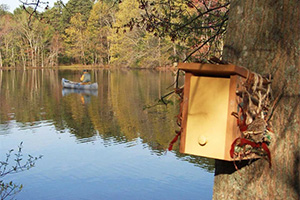
Redolent of David Madacsi’s earlier statement about knowing a place through walking and being attentive to the moment of one’s sensuous presence in the world, a sense of place according to Edward Casey is “the most fundamental form of embodied experience.” In the instance of the poetry boxes, consciousness deepens as the observer moves from looking and reading to dialogic interaction with the boxes by commenting in the notebook or composing a poem in response. To expand Casey’s thoughts, not only is the experience of a particular site a “powerful fusion of self, [place] and time,” but it is also enhanced by a unique aesthetic and creative engagement.
Community
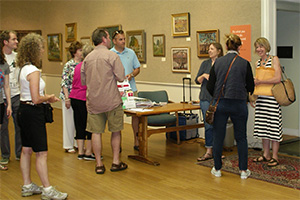
On this hot summer day the POW group became a temporary community by association, distinct from the hordes of tourists streaming through the Mystic streets seeking ice cream or beer. All afternoon the poetry group moved against the flow of pleasure-seekers following various poets and artists to different locations of enchanted poetry boxes. The tangible aspects of the poetry boxes are the visual elements, the poetic words, and the materiality whereas the intangible aspects are community formation and individuals discovering their creativity.
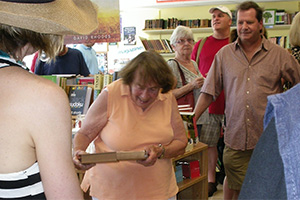
The poetry notebooks found in the boxes also reveal the existence of subcultures such as letterboxing through the appearance of stamps and geocaching (accumulating sites) or orienteering using GPS systems.
Performance
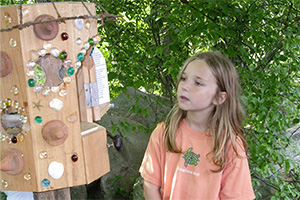
Traditionally, performance is susceptible to context whether it is influenced by the wind whipping through one’s hair and snatching at spoken words or the disturbing presence of mosquitoes. Folklorists were some of the first to discover that through performance in context – all tradition is change. Poetry of the Wild poetry readings demonstrate the vitality of recitation as a communicative and reciprocal action – a point in time that links the venerable bardic tradition to the in-the-moment vernacular. These events involve the still moments of listening and registering sounds, silences, being attuned to the group settling into each experience, the crush of a crowd.
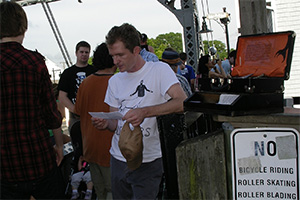
Participation is also dynamic and perambulatory as people walk from box to box. Diane Barcelo, an artist and veteran of a couple POW projects, describes her fascination with the cadence of walking as a group in motion heading to the next spot: the experience of participation as performance.
Poetics, Aesthetics & Design
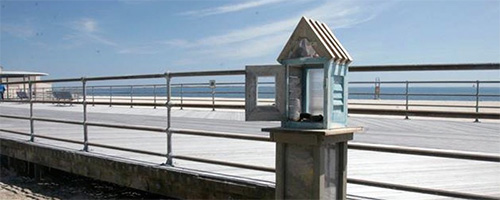
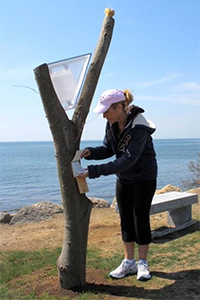
Ana Flores believes that POW “is a catalyst for community and individual creativity that is unpretentious.” The boxes are surprise “objects” in the landscape, which are accessible and design oriented. There is a kind of ‘artistic democracy’ underlying POW. The prominent feature of these boxes is an aesthetically inspired collaboration between a local artist and poet (both living and classic voices). In the case of actual collaboration, it must be meaningful to both. Poet Jose Gonzalez characterizes this melding of genres in these words about the Avery Point installation, “This Poetry of the Wild gave me a refreshing perspective on how poetry and art can come together without boundaries. The poetry boxes are really stuff of museums yet this project turned that idea upside down and brought the art to the outdoors where the people were.” Aaron Anstett, Colorado poet, echoes Jose’s thoughts in these words describing the concept of POW, “And there’s the lovely idea of the outdoors being a temporary gallery space.”
As a folklorist, I am curious about human behavior around cultural objects. Poetry of the Wild offers the ideal arena for tracking this kind of behavior – spontaneous, inquisitive, critically involved, emotionally responsive … the list goes on.
David Madasci’s home was inundated in 2012 by Hurricane Sandy and sustained extensive damage. In the aftermath during clean up,
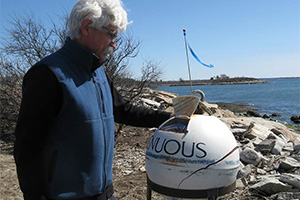
he kept returning to the notion of “tenuous” referring to life and fate. This became a kind of mantra for David and its meaning transformed into his haiku poem for Poetry of the Wild as well as inspiring the name for the “metaphoric” vessel, which he imaginatively associated with his mooring buoy poetry box.
Rising waters churn,
Tenuous moorings straining …
Oblivious Storm
Shrines
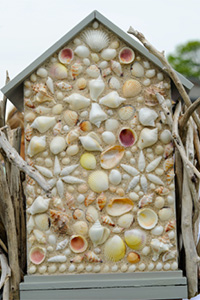
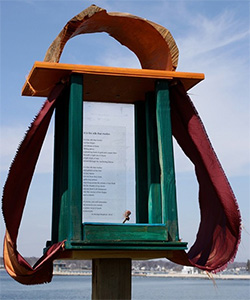
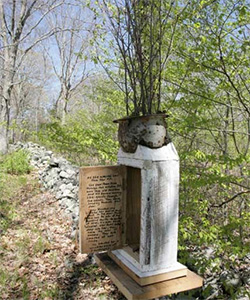
Susan Schultz’s shell-encrusted box is reminiscent of shrines dedicated to the Virgin placed along Italian shores. In this case there is a fine line between the sacred memorializing character of her box and allusions to hobbies of covering every available surface with shell mosaics. The careful application, artistic patterns, and evocative tactility distinguish Susan’s poetry box from shell-adorned lamps and end tables. Concomitant to ritualizing objects, poetry has traditionally been associated with sacredness, perhaps due to the mysteries of conception and creation resulting from the ancient relationship between poet and muse.
In addition to the correlation with shrines along pilgrimage routes, POW shrines evoke a solitary presence like cairns marking the spot as well as marking the way. Elements of surprise, discovery and curiosity also figure into the experience of happening upon shrines similar to encountering poetry boxes. Folklore has a long history of investigating sacredness, ritual, commemorative action and the affecting essence in art. The interpretation of poetry boxes as shrines represents the confluence of several folkloristic leitmotifs such as sacred space, ritual, sense of place, traditional memorials, acts of commemoration, and the creative expressiveness of folk art and folklife.
Artist and poet, Diane Barcelo and Michael Bradford, speak of the radical nature of Poetry of the Wild. The premise could be the democratization of art and poetry. Like the roots of folklore, this project with its many iterations over time and space challenges the boundaries of genres and champions inclusivity. Above all in the words of Ana Flores, it “invites the public out for a walk.”